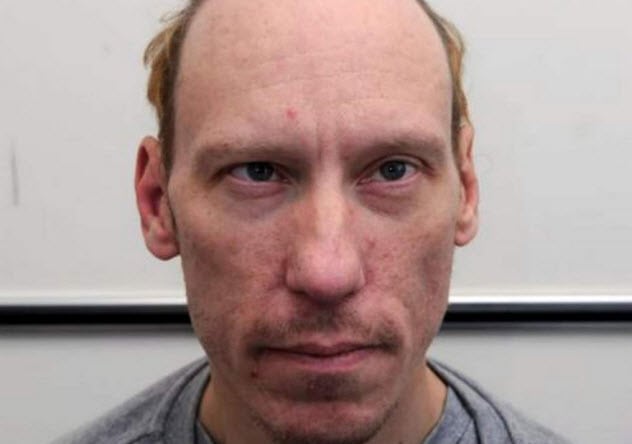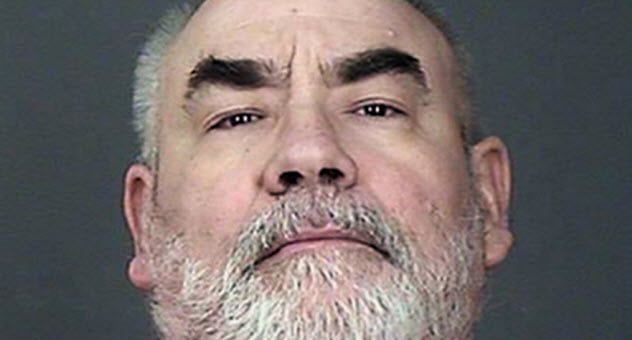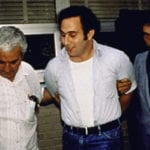 Creepy
Creepy  Creepy
Creepy  Technology
Technology 10 Scientific Breakthroughs of 2025 That’ll Change Everything
 Our World
Our World 10 Ways Icelandic Culture Makes Other Countries Look Boring
 Misconceptions
Misconceptions 10 Common Misconceptions About the Victorian Era
 Mysteries
Mysteries 10 Strange Unexplained Mysteries of 2025
 Miscellaneous
Miscellaneous 10 of History’s Most Bell-Ringing Finishing Moves
 History
History 10 Great Escapes That Ended Right Back in Captivity
 Weird Stuff
Weird Stuff 10 Fascinating Things You Might Not Know About Spiders
 Food
Food 10 Everyday Foods You Didn’t Know Were Invented by the U.S. Military
 History
History 10 Odd Things Colonial Americans Kept at Home
 Creepy
Creepy 10 More Representations of Death from Myth, Legend, and Folktale
 Technology
Technology 10 Scientific Breakthroughs of 2025 That’ll Change Everything
 Our World
Our World 10 Ways Icelandic Culture Makes Other Countries Look Boring
Who's Behind Listverse?

Jamie Frater
Head Editor
Jamie founded Listverse due to an insatiable desire to share fascinating, obscure, and bizarre facts. He has been a guest speaker on numerous national radio and television stations and is a five time published author.
More About Us Misconceptions
Misconceptions 10 Common Misconceptions About the Victorian Era
 Mysteries
Mysteries 10 Strange Unexplained Mysteries of 2025
 Miscellaneous
Miscellaneous 10 of History’s Most Bell-Ringing Finishing Moves
 History
History 10 Great Escapes That Ended Right Back in Captivity
 Weird Stuff
Weird Stuff 10 Fascinating Things You Might Not Know About Spiders
 Food
Food 10 Everyday Foods You Didn’t Know Were Invented by the U.S. Military
 History
History 10 Odd Things Colonial Americans Kept at Home
10 Unbelievably Incompetent Ways Police Failed To Catch Killers
Sometimes, it takes a master criminal to get away with murder. But sometimes, it just takes one incompetent cop.
As it turns out, the men who managed to evade detection for decades weren’t as crafty as it seems. Some of them pretty well got caught with their hands bloody, face-to-face with the men hunting them. And for reasons that you’ll never believe, they were allowed to walk free.
10 Richard Ramirez
The Night Stalker

In the middle of the murder spree that would end up taking 13 lives, Richard Ramirez was nearly arrested by a police officer named John Stavros. But Stavros let him go.
Stavros had caught Ramirez racing through a red light in a stolen car, flying away from the scene of a crime where a woman had just escaped being abducted by a man who fit Ramirez’s description.
“Hey,” Stavros said, slowly piecing together that he might be looking a serial killer in the eye. “You’re not that guy killing people in their homes, are you?”[1]
It was a masterful stroke of police work—the beginning of an interrogation that we swear we are quoting word for word.
Ramirez said that he wasn’t, and for a moment, the officer was satisfied. Stavros was willing to suspect that this man had killed and raped multiple women, but he wasn’t about to call him a liar. Still, a distinct possibility seems to have dawned on Stavros: What if Ramirez was the Night Stalker, and he’d just forgotten?
“You . . . sure you’re not him?” Stavros asked.
Ramirez kindly reassured him: “Hey, man, it’s not me.”
Perhaps Stavros should have been a little suspicious when Ramirez started praying to Satan and scratching a pentagram into the hood of his stolen car. Perhaps Stavros should have done a little more to stop Ramirez when he leaped over a fence and ran away.
And maybe if Stavros had reported all this to the other police officers, they would have found the mountain of evidence that was inside the car Ramirez left behind—evidence that, when they did find it, ended up cracking the case.
Ramirez, though, had promised he wasn’t a serial killer. It just wouldn’t be right not to take him at his word.
9 Paul Bernardo
The Scarborough Rapist

When word got out that a mysterious man was attacking and raping women around Scarborough, Alex and Van Smirnis were pretty sure they knew exactly who was doing it. The only person they’d ever met creepy enough to do this was their childhood friend Paul Bernardo—and they called the cops multiple times to tell them exactly that.
On Alex Smirnis’s tip, the police actually called Paul Bernardo in, interrogated him, and took DNA samples from him.
Then the police passed the evidence on to the forensic department, but the experts there never actually bothered to test those DNA samples. They also didn’t test them a mere 33 days later when they were called to Bernardo’s house, where his sister-in-law and first murder victim, Tammy Homolka, was lying dead on the floor.
They didn’t test his DNA samples when they realized that Tammy had been drugged, brutally raped, and had choked on her vomit before dying. (Bernardo had told them that she died of an asthma attack.) Nor did they test his DNA samples when they realized that Bernardo had lied when he said he called the police as soon as Tammy got sick and, instead, she had already been dead for 20 minutes before he told anyone.
They also didn’t test his DNA samples when the Smirnis brothers repeatedly called the police, trying to convince them that Bernardo was the man behind these crimes.
And the experts would fail to test those DNA samples for almost two-and-a-half years before they realized that they could have stopped Bernardo before he killed anybody if they’d just tested the samples in the first place.[2]
8 Phillip Garrido
Jaycee Dugard’s Kidnapper

Phillip Garrido kidnapped Jaycee Dugard in 1991, locked her up in a complex of sheds and tents in his backyard, and repeatedly raped and abused her for 18 years before he got caught.
That’s pretty crazy because this wasn’t the first time that Garrido had done it. He was a registered sex offender with a record of kidnapping and raping little girls, and his parole officer and other policemen had visited his house more than 60 times while Jaycee Dugard was there.[3]
It wasn’t like there weren’t any clues. In 2006, one visit was made after neighbors called 911 and told them that Garrido was a registered sex offender who was keeping children locked up in a tent in his backyard.
When the cops showed up, they found a network of cables giving power to an outside shed and found two little girls in his house. They were Jaycee Dugard’s children, the product of Garrido repeatedly raping her, and the girls kept calling Garrido “Daddy” in front of the police. Garrido told the cops that the children were just his nieces. So the cops left without bothering to call his brother, who had no daughters, or to look inside the backyard, where Dugard was locked up.
At one point, a police officer actually saw Jaycee Dugard, sat down with her, and had a conversation with her. However, the officer didn’t put together that he was talking to one of the most well-known missing children in the world inside the home of a convicted child rapist.
When she finally got out, Dugard recalled the officer’s visit, saying: “He made me feel like he didn’t really care.”
7 Gary Heidnik
The Man With Six Women In His Basement

Between November 25, 1986, and March 23, 1987, Gary Heidnik kidnapped six women and locked them in his basement. Until one got out and called 911, the police had no idea that any of the women were there—which was strange because one of the women’s parents had told them.
When Sandra Lindsay, the second woman abducted by Heidnik, went missing, her family immediately called the police for help. They didn’t just know their daughter had been kidnapped. They were pretty sure that Gary Heidnik had done it.
But Julius Armstrong, the detective assigned to the case, dismissed them in a way that would seem unbelievable if you saw it on TV. He actively discouraged them from even trying to find their daughter by telling them, “Why are you worried about your daughter? She’s 25.”
Armstrong only went to Heidnik’s house when Sandra’s parents put pressure on him. Even then, Armstrong did next to nothing. Here’s his investigation in his own words:
“I knocked on the door. I didn’t receive any answer. I left a message for anyone known as Gary to contact West Detectives.”[4]
Heidnik didn’t call, and Armstrong didn’t pursue it any further. “In my mind,” he said later, “this person was missing voluntarily.”
In the end, the women had to save themselves. By then, though, Sandra Lindsay was already dead. The night she died, the police visited Heidnik’s house again, following up on complaints about a strange odor coming from his house. But they accepted Heidnik’s word that he’d just burned his cooking and wouldn’t find out until months later that the smell was Lindsay’s dismembered body roasting on Heidnik’s stove.
6 Stephen Port
The Grindr Serial Killer

Between June 2014 and September 2015, the dead bodies of four men mysteriously showed up in a graveyard just around the corner from Stephen Port’s home.
Benjamin Cohen, CEO of LGBT news site PinkNews, noticed the strange connection between all these deaths and contacted the police to see if they thought there was a link. It was a pretty reasonable assumption. All four men were homosexuals who had died from an overdose of the date-rape drug GHB and had arranged dates on Grindr just moments before their mysterious deaths. And all four men had been found in the same place.
But the police insisted that they’d all died of natural causes and it was all just a weird coincidence that gay men kept dying of drug overdoses in the same place. They told Cohen not to publish anything about it, insisting he’d just scare people over nothing.
They would have gone on doing nothing about it, too, if the sisters of one of the victims, Jack Taylor, hadn’t taken the case into their own hands. They acquired CCTV footage of Taylor going into the graveyard with another man.
The police had seen the video before, but they hadn’t bothered to look into the other man in the video until Taylor’s sisters insisted. When the police investigated, they found out that it was Stephen Port—and they caught him within two days.[5]
5 Gertrude Baniszewski
The Woman Who Tortured Sylvia Likens To Death

When 16-year-old Sylvia Likens was put into her care, Gertrude Baniszewski tortured the girl to death. Over a period of three months, Baniszewski, her children, and some of the neighborhood kids joined in to brutally beat, starve, and torture Likens until it killed her. And it definitely could have been stopped.
Baniszewski’s neighbors, Raymond and Phyllis Vermillion, visited the house and watched Sylvia get tortured. They saw Gertrude’s daughter pour a bottle of scalding water on Sylvia’s face and rub garbage into the wound. Then the neighbors listened to Gertrude’s daughter brag about giving Sylvia a black eye.
When Sylvia screamed out in pain, Baniszewski yelled, “Go up to your room! You are not going to get nothing!” And then, right in front of the Vermillions, she shrieked at the girl whom her daughter had just burned: “I am going to kill you!”
Instead of calling the police, though, the Vermillions turned around and asked if Baniszewski would babysit their children.
Only one neighbor actually called in and complained. She’d heard Sylvia screaming for help and had seen her walking around with open, gaping wounds. When a public health nurse showed up, Baniszewski lied and told her that Sylvia had run away.
She labeled the case as “no follow-up needed.” In her view, nothing that serious had happened. A child had been beaten bloody, had run away from the woman who had abused her, and was now a missing person. It was hardly the type of thing that the authorities needed to worry about.[6]
4 Jeffrey Dahmer
The Milwaukee Cannibal

On May 27, 1991, the police received a call. A boy had fled, naked and bleeding from the anus, from Jeffrey Dahmer’s home. The caller thought it was the type of thing that the cops might want to look into.
Apparently, the police didn’t agree. They showed up to find two 17-year-old girls trying to protect the boy, 14-year-old Konerak Sinthasomphone, from returning with Dahmer to his apartment.
After drugging, assaulting, and trying to lobotomize Konerak earlier, Dahmer had gone to a bar for a drink. Somehow in his dazed and disoriented state, the Laotian boy had escaped Dahmer’s apartment. Although Konerak usually spoke English fluently, he could only manage a few words in broken Laotian due to his physical state.
When the police arrived, Dahmer was back from the bar, but the girls wouldn’t let him take Konerak. Dahmer convinced the cops that Konerak was his 19-year-old consensual lover who had gotten drunk and upset during a quarrel and was bleeding from an innocent minor injury.
Dahmer said that he could take care of the injury at home. The police accepted that this was merely “a domestic squabble between homosexuals” and returned Konerak to Dahmer’s apartment.[7]
The two girls insisted that the cops needed to protect Konerak from Dahmer, but the police were having none of it. They told the girls to get lost.
As if ignoring all these blatant clues wasn’t bad enough, the cops dismissed the stench in Dahmer’s apartment when they forcibly returned the unwilling Konerak there. The place reeked of a dead body rotting in the bedroom. Still, the cops were not motivated to investigate.
After they left, Dahmer assaulted the boy repeatedly and finally killed him. He would murder 17 people before they finally caught him.
3 Danny Heinrich
Jacob Wetterling’s Killer

It took 27 years for police to solve the mystery of who abducted, molested, and killed Jacob Wetterling. Which is strange because they had the killer, Danny Heinrich, in custody within four months. Then they let him go.
Wetterling wasn’t the only boy that Heinrich had attacked. He’d molested six boys. Jared Scheierl, a 12-year-old who escaped alive, had helped the police make a sketch that perfectly matched Heinrich. Scheierl had helped them find fibers on his coat that they could match to Heinrich’s car. In all, he’d given them an airtight case to bring Heinrich in on Scheierl’s own abduction.
He’d even helped them pin Wetterling’s kidnapping on Heinrich. In their investigation, they’d been able to prove that the shoe prints and tire tracks left at the scene of the crime came from Heinrich’s shoes and tires. And so, on February 9, 1990, they brought him in for questioning.[8]
According to Heinrich, the police brought him into a room and told him, “We know it’s you.” Heinrich said, “No, it isn’t.” Then the police said, “It’s you.” Heinrich replied, “It isn’t.” They went back and forth like that for a while before the police gave up and let Heinrich go.
Then they spent the next 27 years trying to pin the case on a random music teacher who had nothing to do with it. Sure, there was a mountain of evidence against Heinrich, but a girl who’d gone on a date with the music teacher had said he was creepy. So the police decided that it had to be the music teacher instead.
2 Robert Pickton
The Serial Killer Who Fed Women To Pigs

When Robert Pickton was arrested in 2002, he claimed to have killed 49 women. That’s a terrifying number. But it’s especially troubling when you think how much lower it could have been.
In the late ‘90s, the RCMP got multiple tips saying that one of Pickton’s friends, Lynn Ellingsen, had been going around telling people that she’d watched him skin a dead prostitute in his barn. She was telling the truth, and in the end, her testimony would be one of the key pieces of evidence that convicted him.
When the RCMP first contacted her, though, she got nervous and said that she hadn’t really seen him do it. They asked her to take a polygraph test. But she backed out, and they decided it was best just to trust that the woman who refused to take a lie detector test was telling the truth.
They were tipped off to Pickton again in August 1999 when someone called in saying that he’d been disposing of dead bodies by dropping off metal drums at a meat-rendering plant. The police checked it out. They followed Pickton and watched him drop off metal drums at a meat-rendering plant. But they didn’t bother to check what was in the drums.[9]
1 Warren Welch, David Pennington, And Ronnie Rusick

Lauria Bible and Ashley Freeman disappeared in a house fire. Freeman’s house had mysteriously burned down, and when the police checked the rubble, they only found the remains of Ashley’s mother inside. They came up with a theory: Ashley Freeman’s father had kidnapped his daughter and her friend, burned down the home, and killed his wife.
There was only one problem with the theory: Ashley Freeman’s father had also died in the house fire. Not only had the investigators not noticed that their prime suspect was lying dead in the middle of the crime scene, but they’d actually stepped on his body multiple times.[10]
The body was found by Lauria Bible’s parents, who came to the crime scene to grieve when the yellow tape came down. Within minutes, they found what a team of professionals had overlooked.
Understandably discouraged by the police work, the Bible family hired two private detectives who found fairly conclusive evidence within a couple of months that Warren Welch was involved in the kidnapping. When they shared their evidence with the police, the detectives were told that they were “interfering” and would lose their licenses if they didn’t butt out.
It took another 17 years before anybody checked Welch’s house. If they’d done it earlier, they would have seen that he had multiple photographs on his walls of the girls kidnapped and tied up. Some pictures showed him posing with the girls shortly before they died.
For more strange facts about serial killers, check out 10 Far-Out Facts And Strange Stories About Serial Killers and 10 Common Misconceptions About Serial Killers.







